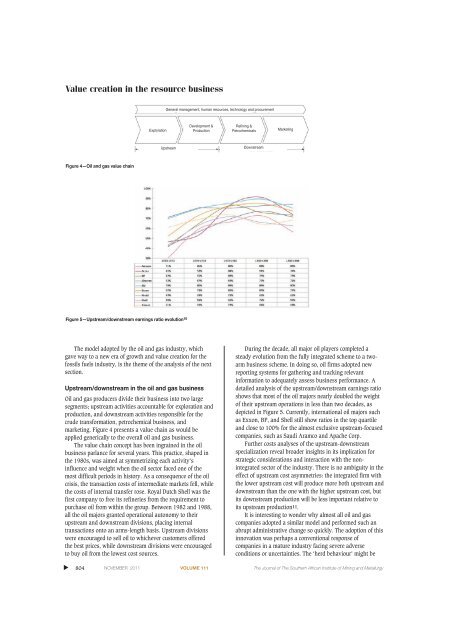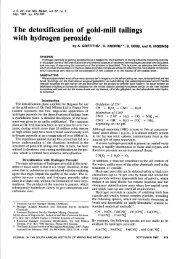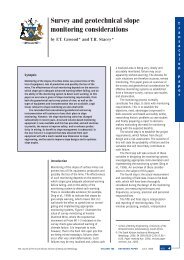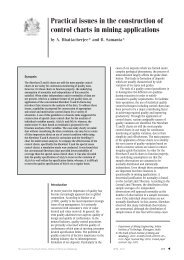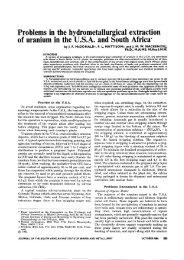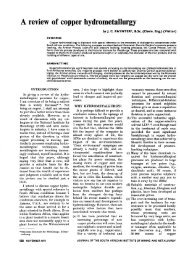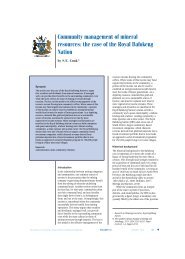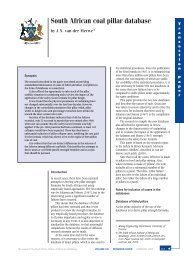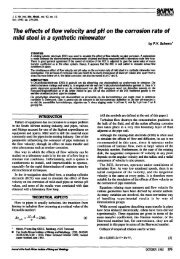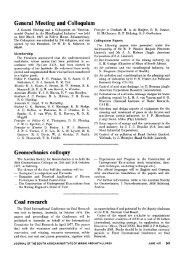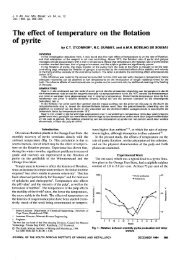Investigation of factors influencing the determination of ... - saimm
Investigation of factors influencing the determination of ... - saimm
Investigation of factors influencing the determination of ... - saimm
Create successful ePaper yourself
Turn your PDF publications into a flip-book with our unique Google optimized e-Paper software.
Value creation in <strong>the</strong> resource business<br />
General management, human resources, technology and procurement<br />
Exploration<br />
Development &<br />
Production<br />
Refining &<br />
Petrochemicals<br />
Marketing<br />
Upstream<br />
Downstream<br />
Figure 4—Oil and gas value chain<br />
Figure 5—Upstream/downstream earnings ratio evolution 10<br />
The model adopted by <strong>the</strong> oil and gas industry, which<br />
gave way to a new era <strong>of</strong> growth and value creation for <strong>the</strong><br />
fossils fuels industry, is <strong>the</strong> <strong>the</strong>me <strong>of</strong> <strong>the</strong> analysis <strong>of</strong> <strong>the</strong> next<br />
section.<br />
Upstream/downstream in <strong>the</strong> oil and gas business<br />
Oil and gas producers divide <strong>the</strong>ir business into two large<br />
segments; upstream activities accountable for exploration and<br />
production, and downstream activities responsible for <strong>the</strong><br />
crude transformation, petrochemical business, and<br />
marketing. Figure 4 presents a value chain as would be<br />
applied generically to <strong>the</strong> overall oil and gas business.<br />
The value chain concept has been ingrained in <strong>the</strong> oil<br />
business parlance for several years. This practice, shaped in<br />
<strong>the</strong> 1980s, was aimed at symmetrizing each activity’s<br />
influence and weight when <strong>the</strong> oil sector faced one <strong>of</strong> <strong>the</strong><br />
most difficult periods in history. As a consequence <strong>of</strong> <strong>the</strong> oil<br />
crisis, <strong>the</strong> transaction costs <strong>of</strong> intermediate markets fell, while<br />
<strong>the</strong> costs <strong>of</strong> internal transfer rose. Royal Dutch Shell was <strong>the</strong><br />
first company to free its refineries from <strong>the</strong> requirement to<br />
purchase oil from within <strong>the</strong> group. Between 1982 and 1988,<br />
all <strong>the</strong> oil majors granted operational autonomy to <strong>the</strong>ir<br />
upstream and downstream divisions, placing internal<br />
transactions onto an arms-length basis. Upstream divisions<br />
were encouraged to sell oil to whichever customers <strong>of</strong>fered<br />
<strong>the</strong> best prices, while downstream divisions were encouraged<br />
to buy oil from <strong>the</strong> lowest cost sources.<br />
During <strong>the</strong> decade, all major oil players completed a<br />
steady evolution from <strong>the</strong> fully integrated scheme to a twoarm<br />
business scheme. In doing so, oil firms adopted new<br />
reporting systems for ga<strong>the</strong>ring and tracking relevant<br />
information to adequately assess business performance. A<br />
detailed analysis <strong>of</strong> <strong>the</strong> upstream/downstream earnings ratio<br />
shows that most <strong>of</strong> <strong>the</strong> oil majors nearly doubled <strong>the</strong> weight<br />
<strong>of</strong> <strong>the</strong>ir upstream operations in less than two decades, as<br />
depicted in Figure 5. Currently, international oil majors such<br />
as Exxon, BP, and Shell still show ratios in <strong>the</strong> top quartile<br />
and close to 100% for <strong>the</strong> almost exclusive upstream-focused<br />
companies, such as Saudi Aramco and Apache Corp.<br />
Fur<strong>the</strong>r costs analyses <strong>of</strong> <strong>the</strong> upstream-downstream<br />
specialization reveal broader insights in its implication for<br />
strategic considerations and interaction with <strong>the</strong> nonintegrated<br />
sector <strong>of</strong> <strong>the</strong> industry. There is no ambiguity in <strong>the</strong><br />
effect <strong>of</strong> upstream cost asymmetries: <strong>the</strong> integrated firm with<br />
<strong>the</strong> lower upstream cost will produce more both upstream and<br />
downstream than <strong>the</strong> one with <strong>the</strong> higher upstream cost, but<br />
its downstream production will be less important relative to<br />
its upstream production11.<br />
It is interesting to wonder why almost all oil and gas<br />
companies adopted a similar model and performed such an<br />
abrupt administrative change so quickly. The adoption <strong>of</strong> this<br />
innovation was perhaps a conventional response <strong>of</strong><br />
companies in a mature industry facing severe adverse<br />
conditions or uncertainties. The ‘herd behaviour’ might be<br />
▲<br />
804 NOVEMBER 2011 VOLUME 111 The Journal <strong>of</strong> The Sou<strong>the</strong>rn African Institute <strong>of</strong> Mining and Metallurgy


